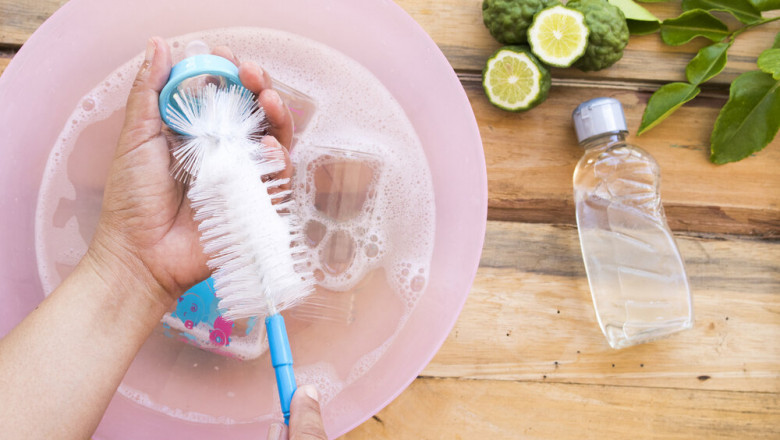views
The Ultimate Guide to Electric Bottle Cleaners | Features, Benefits & Buyer Tips
Bottles—whether for baby feedings, water, or smoothies—need a thorough clean to keep germs at bay. An electric bottle cleaner (also known as an electric bottle brush) turns a chore into a quick, satisfying task. In this guide, we’ll unpack exactly how these gadgets work, explore their top features and benefits, and share smart tips to help you choose the right model for your kitchen or nursery.
What Is an Electric Bottle Cleaner?
An electric bottle cleaner is a motorized tool designed to scrub the inside of bottles, jars, and other narrow vessels. Unlike a traditional brush, it spins or oscillates automatically—breaking up residue without excessive elbow grease. Many models include interchangeable heads, allowing you to switch between:
-
Bottle brushes for tall, slender containers
-
Nipple brushes for feeding bottles and small openings
-
Sponge tips for gentle scrubbing on glass or plastic
By combining power with precision, an electric bottle brush ensures deep, consistent cleaning in seconds.
How Does an Electric Bottle Brush Work?
At its core, the device relies on a small motor housed in a handle. When you twist on the cleaning head and tap the power button, the head begins to spin at hundreds of revolutions per minute. Here’s a typical cleaning routine:
-
Add Soap & Water: Squirt a drop of dish soap into the bottle and fill it partway with warm water.
-
Insert the Brush Head: Choose the appropriate attachment—usually a brush for bottles or a smaller head for nipples.
-
Activate the Motor: Press the button. The head spins, loosening milk residue, juice stains, or smoothie buildup.
-
Move & Rotate: Gently raise and lower the rotating head to reach every corner.
-
Rinse & Dry: Empty the soapy water, rinse thoroughly, and leave the bottle to air dry.
Because the head does the twisting, you avoid wrist strain and uneven cleaning often found with manual brushes.
Key Features to Look For
When shopping for an electric bottle cleaner, certain features make a big difference in performance and convenience:
-
Variable Speed Settings
Adjustable speeds help you match power to the job. Use lower speeds for delicate glassware and higher speeds for stubborn residue. -
Interchangeable Attachments
Look for kits that include multiple heads—narrow brushes, sponge tips, and even scraper tools for nozzles. -
Battery Life & Charging
Cordless models typically run on rechargeable batteries. Check how many cycles you get per charge and whether the unit uses USB charging or a dedicated dock. -
Ergonomic Handle
A soft-grip handle with a balanced weight reduces hand fatigue, especially if you clean numerous bottles at once. -
Water Resistance
True splashproof designs let you submerge the entire brush head without worrying about motor damage. -
Easy Head Removal
Quick-release mechanisms simplify switching heads and make thorough cleaning of the attachments easier.
Advantages of Using an Electric Bottle Cleaner
1. Time Savings
Electric rotation cuts cleaning time in half compared to manual scrubbing. You can tackle multiple bottles while you prep breakfast or pack lunch.
2. Consistent Results
The spinning head applies even pressure all around the bottle’s interior, eliminating missed spots and streaks.
3. Reduced Effort
You simply guide the brush—no more wrist-twisting motions or awkward angles, which is a relief for those with joint issues.
4. Improved Hygiene
Efficient scrubbing removes milk residue and staining more thoroughly, helping prevent bacterial growth and odor buildup.
5. Versatility
Beyond bottles, many electric bottle brushes clean vases, narrow-necked jars, water bottles, and reusable straws with the right attachment.
Maintenance and Care Tips
To keep your electric bottle brush in top shape:
-
Clean Heads After Each Use: Rinse attachments under running water and shake off excess moisture.
-
Deep-Clean Weekly: Soak brush heads in warm, soapy water or vinegar solution to dissolve stubborn deposits.
-
Dry Thoroughly: Store heads and handle separately to prevent mold or mildew.
-
Inspect for Wear: Replace brush heads at the first sign of fraying or deformation.
-
Charge Regularly: Maintain battery health by topping up after every few uses, avoiding full discharges.
Buyer Tips: What to Consider Before Buying
-
Your Bottle Types
If you own a mix of narrow and wide bottles, ensure the cleaner supports varied head sizes. -
Frequency of Use
Heavy users—such as new parents—benefit from robust motors and longer battery life, while occasional users might prioritize cost. -
Storage Space
Compact designs or wall-mount docks save counter space. Check dimensions before committing. -
Noise Level
Some motors run quietly, while others emit a noticeable hum. If you clean early in the morning or late at night, look for low-decibel models. -
Budget vs. Features
Entry-level brushes start around an affordable price point, but premium models offer extras like UV sterilization or smart timers. -
Warranty & Support
A solid warranty and accessible customer service can be lifesavers if you encounter a defect or need replacement parts.
Frequently Asked Questions
Q: Can I use an electric bottle cleaner on glass bottles?
A: Yes. Choose a soft-bristle or sponge attachment to avoid scratches on glass.
Q: How long does a battery charge last?
A: Typical run times range from 30 minutes to over an hour, depending on speed setting and battery capacity.
Q: Is it safe for dishwasher cleaning?
A: Most attachments are dishwasher-safe on the top rack. Always remove heads from the handle before washing.
Conclusion
An electric bottle cleaner or electric bottle brush can transform your cleaning routine, making it faster, more efficient, and surprisingly enjoyable. By focusing on key features—like speed settings, battery life, and attachment variety—you’ll find a model that fits your needs and keeps every bottle sparkling clean. With proper maintenance and informed buying choices, your electric cleaner will become a staple in your kitchen toolkit. Happy cleaning!






















Comments
0 comment